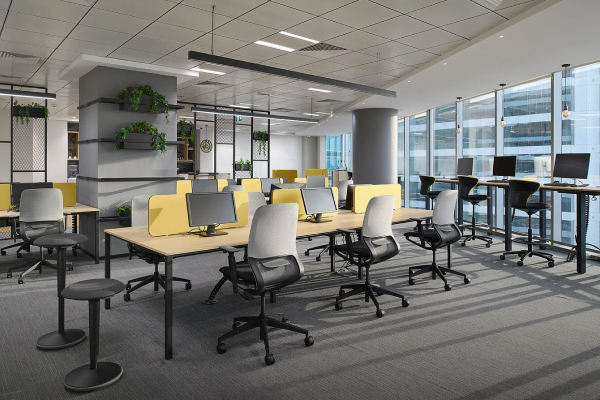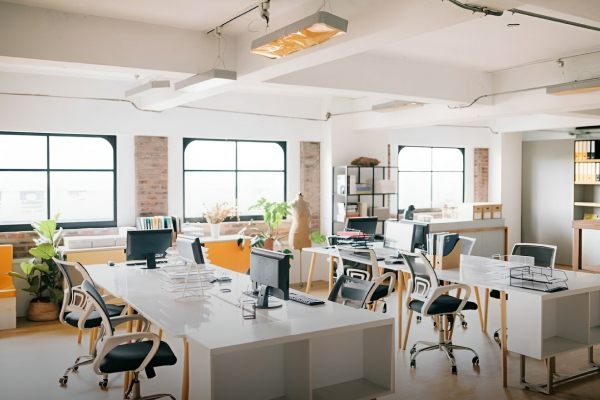Redefining Workspaces: Top Trends in Commercial Interior Design Dubai Professionals Swear By
Office spaces in Dubai no longer look, or feel, the way they used to. The city’s skyline may rise vertically, but its workplaces are evolving horizontally more open, flexible and built around human flow.
Commercial interior design in Dubai has become less about appearance and more about alignment: aligning work patterns with design logic, energy goals with sustainability codes and brand stories with built form.

This shift didn’t happen overnight. It grew from the region’s push for efficiency, the hybrid work revolution and the city’s own design maturity. Today’s Dubai offices blend comfort with capability, where every design choice from lighting to layout adds meaning, not clutter.
Here’s a look at the trends driving that change and why top professionals in Dubai are swearing by them.
1. Flexible Layouts for a Hybrid Workforce
Work is no longer confined to desks. The pandemic accelerated a global shift toward hybrid work models and Dubai’s commercial interiors now reflect that adaptability. Offices are being reimagined as multi-purpose environments that accommodate focused work, collaboration and relaxation in the same footprint.
Designers are focusing on modular furniture, movable partitions and adaptive layouts that can change with team size or project needs. This flexibility reduces the cost of frequent renovations and helps companies use their real estate more effectively.
At AAA, spatial planning often starts with understanding client workflows where teams gather, how departments interact and how privacy or openness impacts productivity. The result is design that’s not just visually appealing but operationally efficient, saving time, cost and space over the long term.
Key takeaway: Future-ready workspaces are designed to move with you not against you.
2. Sustainability: The New Design Currency
In Dubai, sustainability is no longer an optional goal, it’s a design standard. Businesses increasingly value interiors that support the UAE’s Net Zero 2050 vision, both for compliance and reputation.
Sustainable commercial design focuses on resource efficiency, lifecycle performance and wellbeing. Key strategies include:
- Natural Light: Maximising daylight reduces artificial lighting costs and boosts employee wellbeing.
- Eco-materials: Recyclable finishes, FSC-certified wood and low-VOC paints are replacing traditional materials.
- Energy Efficiency: Smart HVAC systems and motion-based lighting reduce energy waste.
But the real advantage comes from design integration where MEP, architecture and interiors align from the start. At AAA, designers and engineers collaborate early in the process, ensuring that sustainability is built in, not added later.
Client benefit: Reduced operational costs, faster compliance approvals and healthier workplaces that appeal to both staff and investors.
3. Wellness-Centred Design
The design of a workspace has a direct impact on mood, focus and overall wellbeing. And in a city that thrives on innovation, companies are beginning to recognise that wellness is a business advantage.
Modern interiors in Dubai now include biophilic design principles, natural light, greenery, water features and textures that mirror nature. These elements don’t just make a space beautiful; they improve air quality, reduce stress and encourage movement.
In several commercial projects, AAA’s approach has involved optimising indoor environmental quality from acoustic balance to thermal comfort ensuring spaces are both productive and restorative. Small shifts like soundproofed pods, ergonomic furniture and open-break areas are proving invaluable in employee retention and performance.
Why it matters: A workspace that supports wellness becomes a long-term asset that attracts talent and reduces turnover.
4. Technology-Driven Interiors
Dubai’s vision of a smart city has entered its buildings. Technology is no longer a support tool, it’s part of the design language itself.
Commercial interiors now integrate IoT, AI and automation to enhance comfort, security and energy performance. Motion sensors, climate control systems and smart lighting adapt to usage patterns, while digital displays and touchless controls promote hygiene and efficiency.
AAA’s interior planning teams often work with IT and engineering experts to ensure that the technological core of a building aligns with its physical form. Cables, panels and systems are planned within the walls not as afterthoughts allowing a clean, future-proof aesthetic.
This approach also ensures scalability. When technology evolves, the space doesn’t need major retrofits, only intelligent upgrades.
For clients: Smarter interiors translate to fewer operational disruptions, stronger data efficiency and more sustainable management.
5. Design as a Reflection of Brand Identity
In Dubai’s current market, an office isn’t just where work happens it’s where brand stories come alive. Interior design has become a subtle yet powerful form of communication.
From colour psychology to spatial zoning, every design choice is crucial. A financial firm might prefer solid materials and neutral tones to express trust and permanence. A tech startup, meanwhile, might choose open plans, bold colours and playful textures that encourage innovation.
AAA’s design philosophy focuses on functional storytelling creating spaces that reflect the company’s values through architecture and detail. Reception areas, breakout lounges and even lighting choices are curated to leave an impression not just on clients, but on the people who work there every day.
For decision-makers: A well-designed office enhances perception, culture and retention: three pillars of lasting success.
6. Adaptive Reuse and Smart Retrofitting
With prime real estate becoming scarce, more developers in Dubai are turning to adaptive reuse converting older properties into efficient, modern workspaces.
This approach blends sustainability with practicality. Instead of demolishing and rebuilding, retrofitting allows for structural reuse while introducing new systems for performance and aesthetics.
AAA has applied this principle in refurbishing offices and institutional buildings, where the focus lies on improving MEP systems, acoustics and layout efficiency without disrupting the structure.
The client’s gain: Reduced downtime, lower cost per square metre and a modernised asset that aligns with sustainability goals.
7. The Human Factor in Design
Beyond technology and efficiency, what defines the success of a workspace is how it feels to the people inside. Dubai’s modern workspaces are evolving from being functional boxes to human-first environments that foster belonging.
Designers are blending psychology with planning using colour, acoustics and spatial rhythm to influence how people collaborate or unwind.
A common example: calm zones with neutral palettes for deep work and vibrant breakout spaces for interaction. The goal is to support both focus and flow two opposing but essential aspects of productivity.
For AAA, this translates into design that reads the rhythm of the workplace, understanding when to create quiet, when to encourage connection and how to make every square metre matter.
8. Local Context and Cultural Relevance
Dubai’s commercial interiors are increasingly reflecting a sense of place something global design trends often overlook.
Incorporating Arabic patterns, textures and spatial hierarchies adds a layer of authenticity while meeting modern demands. Materials like stone, wood and metal are used thoughtfully, merging regional craft traditions with contemporary execution.
This balance creates interiors that feel both global and grounded; spaces that respect heritage while serving modern business needs.
Client advantage: Cultural relevance builds emotional connection and long-term brand alignment in the Middle East market.
The Future of Commercial Interior Design in Dubai
The future of commercial interior design in Dubai isn’t about choosing between technology and human comfort, it’s about blending both seamlessly. The best workspaces will continue to evolve as living ecosystems: efficient, adaptive and meaningful.
As companies compete for talent and visibility, the spaces they occupy will define their credibility as much as their products or services. A well-designed workspace is no longer a luxury; it’s a strategic investment in productivity and brand value.
Dubai’s commercial interiors are evolving beyond beauty. They are becoming ecosystems of innovation, comfort and identity spaces that reflect a company’s purpose and potential.
At AAA, design begins with one question: What does this space need to do and for whom?
From layout to lighting, from sustainability to storytelling, every detail is guided by that answer.
Because in the end, a workspace isn’t just designed, it’s experienced.
If you’re planning a commercial project in Dubai, let’s talk about how thoughtful design can turn your workspace into a long-term asset. Reach out to Abdulla and Associates Engineering & Architectural Consultations to begin your next project with purpose.

